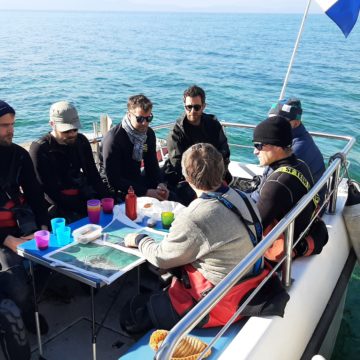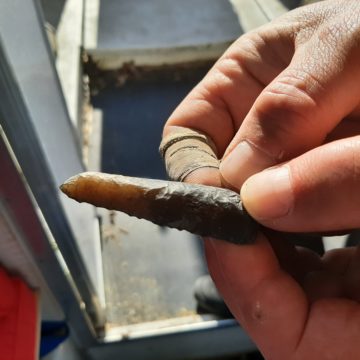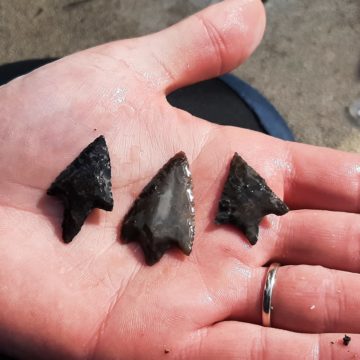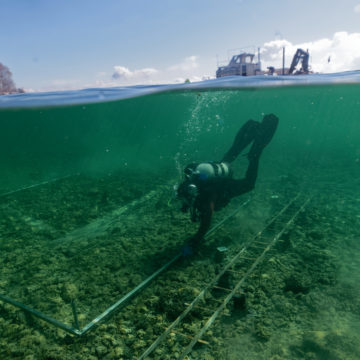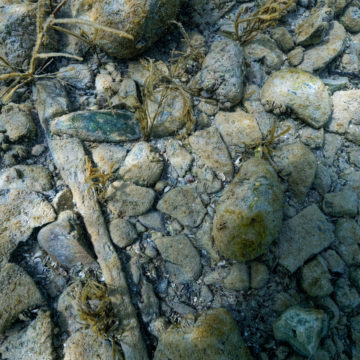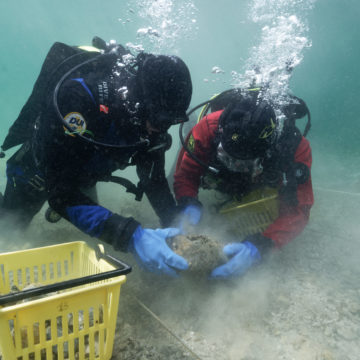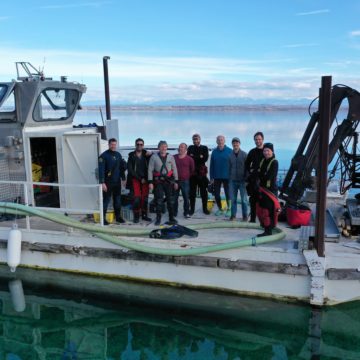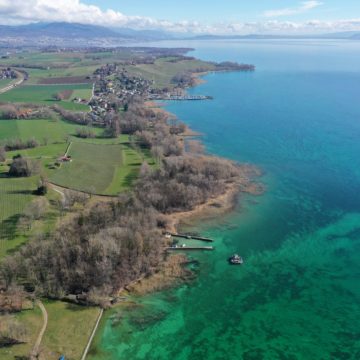After two weeks of diving in the cold waters of Lake Neuchâtel, the Octopus Foundation team has just returned from a field mission particularly rich in discoveries.
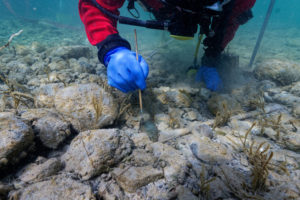 This time we had the immense privilege of accompanying archaeologists from the canton of Neuchâtel in the study of a ancient village (final Neolithic period – around 2500 BC). The good surprise came from the relatively good preservation of the site, despite visible erosion of the bottom of the lake. The team was able to document a 4000-year-old ax, with a long and almost intact wooden handle and green polished stone, in the middle of the sediments and large pebbles that covered and protected the floor.
This time we had the immense privilege of accompanying archaeologists from the canton of Neuchâtel in the study of a ancient village (final Neolithic period – around 2500 BC). The good surprise came from the relatively good preservation of the site, despite visible erosion of the bottom of the lake. The team was able to document a 4000-year-old ax, with a long and almost intact wooden handle and green polished stone, in the middle of the sediments and large pebbles that covered and protected the floor.
The spectacular discovery was the culmination of an exploratory campaign during which two sample areas of 32 square meters were excavated and studied in detail in the heart of the site. This mission was carried out under the scientific direction of Fabien Langenegger and made possible thanks to the collaboration of the archaeological services of Neuchâtel and Fribourg, with the technical and operational support of the Octopus Foundation.
Fabien Langenegger, archaeologist and dendrochronologist at the Office of Heritage and Archeology of the canton of Neuchâtel (OPAN), is among other things responsible for monitoring the underwater heritage of Lake Neuchâtel.
 During regular monitoring flights done aboard an airship, as well as during his diving sessions, Fabien Langenegger notices more and more the exposure of ancient archaeological remains, a consequence of a slow erosion of the bottom of the lake. This erosion may eventually deteriorate or even destroy certain archaeological sites, several of which are listed as UNESCO World Heritage Sites.
During regular monitoring flights done aboard an airship, as well as during his diving sessions, Fabien Langenegger notices more and more the exposure of ancient archaeological remains, a consequence of a slow erosion of the bottom of the lake. This erosion may eventually deteriorate or even destroy certain archaeological sites, several of which are listed as UNESCO World Heritage Sites.
The archaeological site known as Bevaix-Treytel is not one of the 111 pile-dwelling sites of major importance identified around the Alps and registered with UNESCO in 2011 (Switzerland, Germany, Austria, Italy, Slovenia and France). Known since the middle of the 19th century, this lakeside village was partially explored on several occasions between 1857 and 1921 in the terrestrial part of the site, delivering an abundant corpus of archaeological objects. But no research had ever been carried out in the underwater part of the site.
In March 2023, two 32 m2 windows were opened in the heart of the submerged part of the site, about two meters deep. Very quickly, divers realize that the Bevaix-Treytel site is exposed to the same lake erosion phenomena observed elsewhere. Remains appear gradually, despite the presence of a natural protective cover of sand and pebbles.
 As the dives progressed, architectural elements of the old oak houses were revealed. Some massive beams, forming the delimitation of the bases of the houses (spread beams), or even certain floor elements inside the houses have been discovered, measured and recorded in digital 3D models. Inside and around the houses, flint tools like arrowheads or knife blades appeared. Finally, large quantities of animal bones were also uncovered within the walls of the houses. Near one of the houses, the discovery at the top of the archaeological layer of an entire ax (wooden handle and polished stone blade) testifies to the good preservation of the Treytel site, at least in the areas explored during this 2023 campaign.
As the dives progressed, architectural elements of the old oak houses were revealed. Some massive beams, forming the delimitation of the bases of the houses (spread beams), or even certain floor elements inside the houses have been discovered, measured and recorded in digital 3D models. Inside and around the houses, flint tools like arrowheads or knife blades appeared. Finally, large quantities of animal bones were also uncovered within the walls of the houses. Near one of the houses, the discovery at the top of the archaeological layer of an entire ax (wooden handle and polished stone blade) testifies to the good preservation of the Treytel site, at least in the areas explored during this 2023 campaign.
Unlike traditional excavations, one of the characteristics of this mission was the desire to preserve the remains in situ, to increase their chances of preservation. Once the remains were exposed, studied and 3D modeled in their original location in the water, archaeologists and the Octopus Foundation team again covered them with a protective layer of sand and pebbles. A fastidious entreprise, necessary to ensure long-term conservation, since all materials composed of organic matter such as wood degrade extremely quickly when exposed to air. As long as objects are covered in sediment, fresh water acts as the best preservative.
This new technique of non-destructive underwater excavation (divers reveal, document and then recover) is currently being studied in order to demonstrate its future relevance. If successful, it might be possible to consider it on an ad hoc basis for certain sites classified by UNESCO if they are in danger of destruction.

